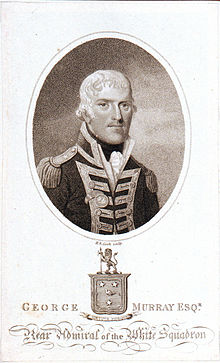George Murray (Royal Navy officer)
ViceAdmiral Sir George Murray KCB was an officer in the Royal Navy who saw service in a wide range of theatres and campaigns. His active naval career spanned the American War of Independence and the French Revolutionary and Napoleonic Wars. Murray served under many of the most notable commanders of his age and participated in several of their greatest victories. He was with Parker and Howe in the West Indies and North America, Johnstone and Hughes in the East Indies, Jervis at Cape St Vincent, Nelson at Copenhagen, and took part in a host of other actions and engagements. Temporarily a captive of the French he was a keen scholar and spent time learning the French language and their naval customs, as well as being a competent surveyor, experience that was to help him in later life. He had a particularly enduring friendship with Nelson, who personally requested his services as his captain of the fleet. It was only chance that prevented Murray from serving as such at Trafalgar. With Murr
George Murray was born in Chichester in January 1759. His father was Gideon Murray, Alderman of that city. He began his naval career at the age of 11, when he was entered in the books of Captain Francis Bankss HMS160Niger, which was serving in the Mediterranean, as a captains servant. His proper service in the navy likely began in 1772, when he joined HMS160Panther, the flagship of Commodore Molyneux Shuldham, for service on the Newfoundland station. He then transferred to the flagship of John Montagu, the 50gun HMS160Romney, and again in time to join Sir Peter Parkers flagship HMS160Bristol for the attack on Sullivans Island onJune 1776. He moved into HMS160Chatham after this and continued to serve with Parker along the North American coast, participating in the occupation of Rhode Island in December 1776. After receiving favourable reports of his conduct, ViceAdmiral Lord Howe requested Murrays services and he was transferred to HMS160Eagle. Murray went on to see action in Howes
Source: Wikipedia

